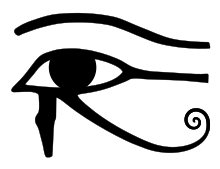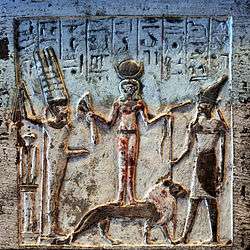Qetesh
Qetesh (also Qadesh, Qedesh, Qetesh, Kadesh, Kedesh, Kadeš or Qades /ˈkɑːdɛʃ/) is a goddess, who was adopted during the late Bronze Age from the religion of Canaan into the ancient Egyptian religion during its New Kingdom. She was a fertility goddess of sacred ecstasy and sexual pleasure,[1] and became a popular deity.
| Qetesh | |
|---|---|
.png) A digital collage showing an image of Qetesh together with hieroglyphs taken from a separate Egyptian relief (the ‘Triple Goddess stone’) | |
| Abode | Qadesh |
| Symbol | Lion, snake, lotus flowers |
| Equivalents | |
| Canaanite equivalent | Astarte |
| Part of a series on |
| Ancient Egyptian religion |
|---|
 |
|
Beliefs |
|
Practices
|
|
Deities (list) |
|
Locations |
|
Symbols and objects
|
|
Related religions
|
|
|
The name was probably vocalized by Egyptians as, *Qātiša, from the Semitic root Q-D-Š meaning 'holy'. Her city of worship was Qadesh in present-day Syria.
Representation
On stele representing the deity, Qetesh is represented as a frontal nude standing on a lion, often between Min of Egypt and the Canaanite warrior god Resheph. She holds a snake in one hand and a bouquet of lotus flowers in the other as symbols of creation. Association with Hathor may be seen in imagery as well.
Qetesh is associated with Anat, Astarte, and Asherah. She also has elements associated with the goddesses of Mycenae, the Minoan goddesses of Crete, and certain Kassite goddesses of the metals trade in tin, copper, and bronze between Lothal and Dilmun.
On some versions of the Qetesh stele her register with Min and Resheph is placed over another register showing gifts being presented to ‘Anat the goddess of war and below a register listing the lands belonging to Min and Resheph.
Triple goddess merged into one
Qudshu-Astarte-Anat is a representation of a single goddess who is a combination of three goddesses: Qetesh (Athirat, Asherah), Astarte, and Anat. It was a common practice for Canaanites and Egyptians to merge different deities through a process of syncretism, thereby turning them into one single entity. The "Triple-Goddess Stone", once owned by Winchester College, shows the goddess Qetesh with the inscription "Qudshu-Astarte-Anat", displaying their association as being one goddess, and Qetesh (Qudshu) in place of Athirat. Qadshu is used as an epithet of Athirat, the Great Mother Goddess of the Canaanites.[2]
Religious scholar Saul M. Olyan (author of Asherah and the Cult of Yahweh in Israel) calls the representation on the Qudshu-Astarte-Anat plaque "a triple-fusion hypostasis", and considers Qudshu to be an epithet of Athirat by a process of elimination, for Astarte and Anat appear after Qudshu in the inscription.[3][4]
Epithets
Among the epithets used for this deity, Qetesh is called "Mistress of All the Gods", "Lady of the Stars of Heaven", "Beloved of Ptah", "Great of magic, mistress of the stars", and "Eye of Ra, without her equal".[5]
In popular culture
Qetesh is the name given to the Goa'uld that once possessed Vala Mal Doran, a recurring and then regular character in Seasons 9 and 10, respectively of the science fiction television series Stargate SG-1.
See also
References
- Spooner, Henry G. (1918). American Journal of Urology and Sexology. Urologic Publishing Association.
- "Switching..." www.thaliatook.com. Retrieved 2018-03-19.
- The Ugaritic Baal cycle: Volume 2 by Mark S. Smith, page 295
- The Origins of Biblical Monotheism: Israel's Polytheistic Background and the Ugaritic Texts by Mark S. Smith - Page 237
- "The "Holy One" by Johanna Stuckey". www.matrifocus.com. Retrieved 2018-03-19.
External links
| Wikimedia Commons has media related to Qetesh. |
- Johanna Stuckey, The "Holy One", MatriFocus, 2007

